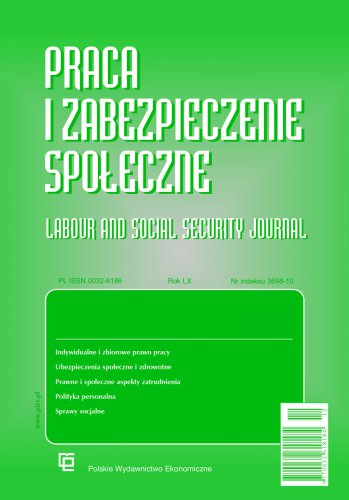Social welfare institutions in response to the COVID-19 pandemic in the light of social workers'
This article aims to present social results ofa quantitative study (CAWI interviews) conducted among social workers from local social welfare centres in the Wielkopolska region — the second largest firstlevel administrative unit in Poland in terms of area. The aim of the research was to diagnose and describe the main changes in the functioning of local social welfare centres during a pandemic COVID-19. The article analyzed social challenges in the face of intensification of existing ones or emergence of new social problems. The article also presented the opinions of social workers to organizational changes in local institutions. The results reveal the opinions of social workers to the social consequences of the COVID-19 pandemic in the context of emerging social problems and new categories of clients. In the light of analysis of the obtained data was also possible to show the impact of a pandemic on the mental well-being of social workers and indicated sources of stress for respondents and self-care strategies.
References
Bibliografia/References
Bieńko, M. (2012). Dylematy profesji i roli w refleksyjnym projekcie tożsamości współczesnego pracownika socjalnego na przykładzie pracowników powiatowych centrów pomocy rodzinie. W: M. Rymsza (red.), Pracownicy socjalni i praca socjalna w Polsce. Między służbą społeczną a urzędem (s. 91–120). Warszawa: Fundacja Instytutu Spraw Publicznych.
Buttell, F. i Ferreira, R. J. (2020). The hidden disaster of COVID-19: Intimate partner violence. Psychological Trauma: Theory, Research, Practice, and Policy, 12(S1), 197–198. http://dx.doi.org/10.1037/tra0000646
Bride, B. E. (2007). Prevalence of secondary traumatic stress among social workers. Social work, (52), 63–70. https://doi.org/10.1093/sw/52.1.63
Gerard, F., Imbert, C. i Orkin, K. (2020). Social protection response to the COVID-19 crisis: options for developing countries. Oxford Review of Economic Policy, 36(S1), 281–296. https://doi.org/10.1093/oxrep/graa026
Henderson, P., i Thomas, D. N. (2013). Umiejętności pomocne w pracy ze społecznością. Warszawa: Centrum Wspierania Aktywności Lokalnej CAL.
Ife, J. (2008). Human Rights and Social Work Towards Rights-Based Practice. New York: Cambridge University Press. https://doi.org/10.1017/CBO- 9780511808326
Kamiński, T. (2017). Pracownicy socjalni — agenci zmiany czy konserwatorzy systemu. Praca Socjalna, 3(34), 29–38.
Kantowicz, E. (2008). Praca socjalna w Europie. Inspiracje teoretyczne i standardy kształcenia. Olsztyn: Wydawnictwo Uniwersytetu Warmińsko-Mazurskiego w Olsztynie.
Kaźmierczak, T., Bąbska B. i in. (2014). Organizator społeczności lokalnej — refleksyjny praktyk. Warszawa: Centrum Rozwoju Zasobów Ludzkich.
Khatri, J., Fitzgerald, G. i Poudyal Chhetri, M. B. (2019). Health risks in disaster responders: a conceptual framework. Prehosp Disaster Med., 34(2), 209–216. https://doi.org/10.1017/S1049023X19000141
Kofman, Y. B. i Garfin, D. R. (2020). Home is Not Always a Haven: The Domestic Violence Crisis Amid the COVID-19 Pandemic. Psychological Trauma: Theory, Research, Practice, and Policy, 12(S1), 199–201. http://dx.doi.org/10.1037/tra0000866
Kotlarska-Michalska, A. (2009). O potrzebie poszerzania ról pracownika socjalnego. W: A. Żukiewicz (red.), Ciągłość i zmiana w pomocy społecznej i pracy socjalnej. Księga jubileuszowa z okazji XV-lecia Miejskiego Ośrodka Pomocy Społecznej w Krakowie. Kraków: Oficyna Wydawnicza „Impuls”.
Kye, B. i Hwang, S-J. (2020). Social trust in the midst of pandemic crisis: Implications from COVID-19 of South Korea. Research in Social Stratification and Mobility, 68, 1–5. https://doi.org/10.1016/j.rssm.2020.100523
Latsuzbaia, A., Herold, M., Bertemes, J. P. i Mossong, J. (2020). Evolving social contact patterns during the COVID-19 crisis in Luxembourg. PLOS ONE 15(8), https://doi.org/10.1371/journal.pone.0237128
Lu, J., Yang, N., Ye, J. i in. (2014). The influence paths of emotion on the occupational safety of rescuers involved in environmental emergencies — systematic review article. Iran Journal of Public Health, 43(11), 1478–1485.
Luong, T., Laopaiboon, M., Koh, D. i in. (2016). Behavioral interventions to promote workers' use of respiratory protective equipment. Cochrane Database of Systematic Reviews, 12, CD010157 https://doi.org/10.1002/14651858.CD010157.pub2
Maslach, C. (2003). Burnout: The cost of caring. Cambridge: Malor Books.
Mathbor, G. M. (2007). Enhancement of community preparedness for natural disasters. The role of social work in building social capital for sustainable disaster relief and management. International Social Work, 50(3), 357–369. https://doi.org/10.1177/0020872807076049
Międzynarodowa Organizacja Zdrowia. (2020, 3 listopada). The rise and rise of interpersonal violence — an unintended impact of the COVID-19 response on families. Artykuł pozyskano z https://www.euro.who.int/en/health-topics/disease-prevention/violence-and-injuries/ news/news/2020/6/the-rise-and-rise-of-interpersonal-violence-an-unintended-impact-of-the-covid-19-response-on-families
Necel, R. (2016). Orientacja innowacyjna pracownika socjalnego — teoretyczne perspektywy i determinanty rozwoju. W: A. Kotlarska-Michalska i P. Nosal (red.), Zaradność społeczna. Współczesne przejawy i ograniczenia (s. 165–176), Poznań: Wydawnictwo Naukowe Wydziału Nauk Społecznych
UAM.
Newman, D. M. (2012). Protecting disaster responders' health: lessons (not yet?) learned. New Solut, 21(4), 573–590. https://doi.org/10.2190/NS.21.4.f
Rothman, J. (2007). Multi Modes of Intervention at the Macro Level. Journal of Community Practice, 15, 11–40. https://doi.org/ 10.1300/J125v15n04_02
Kaźmierczak, T. (2012). Pracownicy socjalni, kapitał ludzki, profesjonalna praktyka. W: M. Rymsza, Pracownicy socjalni i praca socjalna w Polsce. Między służbą społeczną a urzędem (s. 203–226). Warszawa: Fundacja Instytutu Spraw Publicznych.
Seddighi, H. (2020). COVID-19 as a Natural Disaster: Focusing on Exposure and Vulnerability for Response. Society for Disaster Medicine and Public Health, s. 1–2. https://doi.org/10.1017/dmp.2020.279
Skinner, S. (2014). Silniejsze społeczności. Jak budować potencjał społeczności i sektora publicznego. Warszawa: Centrum Wspierania Aktywności Lokalnej CAL.
Stamm, B. (2009). Measuring compassion satisfaction as well as fatigue: Development history of the Compassion Satisfaction and Fatigue Test. W: Ch. R. Figley (red.), Treating compassion fatigue. Psychosocial stress series (s. 107–119). New York: Brunner-Routledge.
Szmagalski, J. (2014). Praca socjalna wobec katastrof i klęsk żywiołowych. Warszawa: Instytut Rozwoju Służb Społecznych.
Trawkowska, D. (2006). Portret współczesnego pracownika socjalnego. Studium socjologiczne. Katowice: Wydawnictwo Naukowe „Śląsk”.
Twelvetrees, P. (2014). Pracując ze społecznością. Warszawa: Centrum Wspierania Aktywności Lokalnej CAL.
Wankmüller, C. (2020). European disaster management in response to the COVID-19 pandemic. Mind Soc. https://doi.org/10.1007/s11299-020-00252-2
Żukiewicz, A. (2002). Praca socjalna ośrodków pomocy społecznej. Wrocław: Wydawnictwo Uniwersytetu Wrocławskiego.

